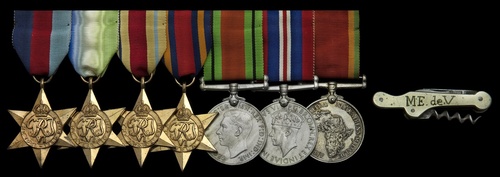
Auction: 24003 - Orders, Decorations and Medals
Lot: 131
(x) The 'Discovery Antarctic Investigations 1926' campaign group of seven awarded to Able Seaman J. H. Slabber, South African Naval Forces, attached Royal Navy who served in the Antarctic with the Research Ship Discovery later surviving the sinking of H.M.S. Hermes in 1942
1939-45 Star; Atlantic Star; Africa Star; Burma Star; Defence and War Medals 1939-45; Africa Service Medal 1939-45, all named '330596 J. H. Slabber' in the South African style, mounted as worn, slight polishing, very fine (7)
Jacobus Hendrick Slabber was born in the Malmesbury District, South Africa on 8 March 1908 to an alcoholic father who soon found the behaviour of his children too much to take. As a result Slabber and his brothers were raised in an orphanage and at the age of 16 he joined the South African Training Ship, General Botha on a Bursary. Serving there until the age of 18 he was appointed Able Seaman and on his graduation in 1925 won the King's Gold Medal.
After this he was posted to the RRS Discovery on 16 January 1926 as she was involved in the 'Discovery Investigations', whilst based out of South Georgia Island. While he was aboard she conducted surveys of the whaling grounds around South Georgia and the South Shetland Islands which resulted in the discovery of the Antarctic Convergence. Slabber's photo album depicts numerous images of this voyage including the crossing of the Roaring Forties, a football match in the frozen conditions and the piles of whalebones outside the old whaling stations of St. George's Island.
He left Discovery on 30 June 1927 and served as a cleaner on the railways prior to joining the SS Aloe. Enlisting with the South African Naval Forces on 17 September 1939 he was posted to the cargo ship Bulolo on 28 December 1939, during her conversion to a Merchant Cruiser. She served as part of the Freetown Convoy Escort Group operating between South America, South Africa and Britain.
Leaving her in May 1941 he briefly served with the cruiser Hawkins before being transferred to Hermes. This elderly aircraft career had been undergoing a refit in Simonstown and was soon detailed to support the British forces in Italian Somaliland before transferring to Trincomalee.
They undertook operations in the Indian Ocean, including the British invasion of Iraq and was being prepared for service in the Invasion of Madagascar in spring 1942. Warning of a Japanese raid incoming on Trincomalee resulted in Hermes and Vampire being ordered to sail down the coast to avoid attack. Unfortunately they were spotted and a huge number of Japanese aircraft attacked them, with counts reaching over 70.
Hermes was an aging ship yet despite this, contemporary accounts have her withstanding a number of direct hits before finally going down. The attack was carried out with immense skill, in a letter to his wife, Slabber describes the relentless attack:
'I know you will be awfully upset about the news, that the old ship has been sunk. So I wired you as soon as I could. I'm absolutely O.K. not even a scratch. It was awful while it lasted. Almost every bomb was a direct hit and a poor old ship shuddered and listed over the one side in her agony. One or two bombs came very close to where I was, except for fumes, that blinded and chocked me, I think I was well off. It's terribly unnerving when you are in a position from which you can't see what's happening, for you feel that the next one is coming down on you.
I was lucky in a way, for my life belt was leaky, and in my locker. When we were warned to expect and attack, I looked around, and found an old life belt, and it certainly helped me. Luckily, I had on my watch, and money belt. After two hours in the water and fuel oil, it's still going strong, and not a minute out,
I was stationed on the No 3 Gun portside (left). I believe that just after I left the ship she got hit there. She rolled over to that side too, so it was just well we were told to abandon the ship before. Gosh there were some fritiful [SIC] sights on which I do not wish to dwell'
In the short-term Slabber was stationed at Lanka before returning to South Africa in August 1942 and serving there for the rest of the war. He spent most of it on the books of the base ship in Simonstown but also undertook a period of service with the Combined Operations training centre Assegai.
After the war Slabber joined the Postal Service as a Postman Grade 1 at Johannesburg on 29 August 1946. He was in the rank of Telephone Exchange Superintendent upon his retirement at the Pietermaritzburg Office on 23 February 1968; sold together with copied service papers as well as an archive of original material comprising:
i)
An unbound photograph album and various loose photographs.
ii)
Penknife and two buttons.
iii)
Personal papers including discharge papers for RRS Discovery.
iv)
Various letters including a letter detailing the loss of H.M.S. Hermes.
v)
Employment papers relating to his post-war work.
vi)
Notebook.
vii)
A large number of newspaper clippings several mentioning the recipient by name.
Subject to 5% tax on Hammer Price in addition to 20% VAT on Buyer’s Premium.
Sold for
£1,000
Starting price
£320




